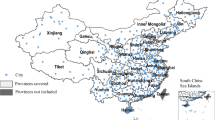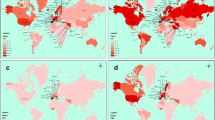Abstract
The COVID-19 virus rapidly expanded worldwide and infected people from most of the countries (215) within a span of three months. The virus did not spare even the remote geographical areas, including the remote regions of India’s hilly north-eastern states. According to the Ministry of Health and Family Welfare (MoHFW, GoI), report 2021, the recovery rate of the Aizawl district was very low, but the positivity rate was high during the second wave of this pandemic, compared to the national average. Hence, the present work is aimed at analysing the spatial pattern of COVID-19 in Mizoram through hotspot analysis and forecasting the trend of coronavirus spread using the susceptible-exposed-infected-removed (SEIR) model. To show the clustering pattern of COVID-19 in Aizawl we used Getis-Ords Gi* statistic. The Getis-Ords Gi* statistic defines a cluster of values that are higher or lower than expected by chance giving the output as a z score.Getis-Ords Gi* statistic, also known as “hotspots” and “coldspots”, identify the clustering pattern of high and low values in a spatial distribution.To perform the Getis-Ords Gi* statistic the authors used the monthly average of COVID-19 data for the study period.During the study done between September 2021 and March 2022, hotspot analysis identified the city areas as hotspot zones, while the periphery of city limits was identified as coldspot zones. The forecast was made for 45 days (from July 27th to September 10th, 2022). An ROC curve has been used to validate the prediction result. The area under the curve (AUC) is 76.71%, signifying the validation of the prediction. This research will assist policymakers and the government in developing health management policies to mitigate the effects of a future pandemic.









Similar content being viewed by others
Data Availability
Data supporting this study are included within the article.
References
Anastassopoulou, C., Russo, L., Tsakris, A., &Siettos, C. (2020). Data-based analysis, modelling and forecasting of the COVID-19 outbreak. PLOS One, 15(3), e0230405.
Andrews, M. A., Areekal, B., Rajesh, K. R., Krishnan, J., Suryakala, R., Krishnan, B., & Santhosh, P. V. (2020). First confirmed case of COVID-19 infection in India: A case report. The Indian Journal of Medical Research, 151(5), 490.
Anselin, L. (1988). Spatial econometrics: methods and models (Vol. 4). Springer Science & Business Media.
Anselin, L. (2019). The Moran scatterplot as an ESDA tool to assess local instability in spatial association. In Spatial analytical perspectives on GIS (pp. 111–126). Routledge.
Arora, C., Khetarpal, P., Gupta, S., Fatema, N., Malik, H., &Afthanorhan, A. (2023), Mathematical Modelling to Predict the Effect of Vaccination on Delay and Rise of COVID-19 Cases Management, Mathematics, 11 (4), 821. DOI: https://doi.org/10.3390/math11040821
Arti, M. K., & Bhatnagar, K. (2020). Modeling and predictions for COVID 19 spread in India. ResearchGate, DOI: DOI, 10.
Azevedo, L., Pereira, M. J., Ribeiro, M. C., & Soares, A. (2020). Geostatistical COVID-19 infection risk maps for Portugal. International Journal of Health Geographics, 19(1), 1–8.
Bagal, D. K., Rath, A., Barua, A., & Patnaik, D. (2020). Estimating the parameters of susceptible-infected-recovered model of COVID-19 cases in India during lockdown periods. Chaos, Solitons & Fractals, 140, 110154.
Bedford, J., Enria, D., Giesecke, J., Heymann, D. L., Ihekweazu, C., Kobinger, G., … WHO, S. Technical Advisory Group for Infectious Hazards. 2020. COVID-19: towards controlling of a pandemic. Lancet, 395, 1015–1018.
Bhunia, G. S., Kesari, S., Chatterjee, N., Kumar, V., & Das, P. (2013). Spatial and temporal variation and hotspot detection of kala-azar disease in Vaishali district (Bihar), India. BMC Infectious Diseases, 13(1), 1–12.
Biswas, B., &Rahaman, A. (2021). The Impact of COVID-19 Pandemic on Education Sector: A Case Study from Mizoram, India.Ensemble:1 (spl issue) https://doi.org/10.37948/ensemble-2021-sp1-a018
Biswas, B., Das, K., & Chouhan P., (2022). Assessment of COVID-19 pandemic healthcare infrastructure of Mizoram, India. International Journal of Health Science, 6(S6), 3535–3554. https://doi.org/10.53730/ijhs.v6ns6.10188.
Brauer, F. Mathematical epidemiology: past, present, and future. Infectious Disease Modelling. 2, 113–127 (2017).
Diagne, M. L., Rwezaura, H., Tchoumi, S. Y., &Tchuenche, J. M. (2021). A mathematical model of COVID-19 with vaccination and treatment, Computational and Mathematical Methods in Medicine, 1250129. DOI: https://doi.org/10.1155/2021/1250129
Fanelli, D., & Piazza, F. (2020). Analysis and forecast of COVID-19 spreading in China, Italy and France. Chaos, Solitons & Fractals, 134, 109761.
Getis, A., & Ord, J. K. (1992). The analysis of spatial association by use of distance statistics. Geographical analysis, 24(3), 189–206.
Giordano, G., Blanchini, F., Bruno, R., Colaneri, P., Di Filippo, A., Di Matteo, A., &Colaneri, M. (2020). Modelling the COVID-19 epidemic and implementation of population-wide interventions in Italy. Nature Medicine, 26(6), 855–860.
He, S., Peng, Y., & Sun, K. (2020). SEIR modeling of the COVID-19 and its dynamics. Nonlinear Dynamics, 101(3), 1667–1680.
Hethcote, H. W. (2000). The mathematics of infectious diseases. SIAM review, 42(4), 599–653.
Hosmer, D. W., &Lemeshow, S. (2000). Applied logistic regression. Wiley, New York, p 375.
Ibrahim MA, Al-Najafi A. (2020) Modeling, Control, and Prediction of the Spread of COVID-19 Using Compartmental, Logistic, and Gauss Models: A Case Study in Iraq and Egypt. Processes. 8(11):1400. https://doi.org/10.3390/pr8111400
Jin, Y., Wang, M., Zuo, Z., Fan, C., Ye, F., Cai, Z., … Xu, A. (2020). Diagnostic value and dynamic variance of serum antibody in coronavirus disease 2019. International Journal of Infectious Diseases, 94, 49–52.
KamelBoulos, M. N., & Geraghty, E. M. (2020). Geographical tracking and mapping of coronavirus disease COVID-19/severe acute respiratory syndrome coronavirus 2 (SARS-CoV-2) epidemic and associated events around the world: how 21st century GIS technologies are supporting the global fight against outbreaks and epidemics. International Journal of Health Geographics, 19(1), 1–12.
Kankan Sarkar, SubhasKhajanchi& Juan J. Nieto (2020) Modeling and forecasting the COVID-19 pandemic in India. Chaos, Solitons& Fractals, 139:10049. https://doi.org/10.1016/j.chaos.2020.110049
Kaxiras, E., Neofotistos, G., &Angelaki, E. (2020). The first 100 days: Modeling the evolution of the COVID-19 pandemic. Chaos, Solitons & Fractals, 138, 110114.
Koubaa, A. (2020). Understanding the covid19 outbreak: A comparative data analytics and study. arXiv preprint arXiv:2003.14150.
Kumar, R. L., Khan, F., Din, S., Band., S. S., Mosavi, A., &Ibeke, E. (2021), Frontiers in Public Health, 9, 744100, DOI: https://doi.org/10.1007/s42979-023-01746-9
Lai, C. C., Shih, T. P., Ko, W. C., Tang, H. J., & Hsueh, P. R. (2020). Severe acute respiratory syndrome coronavirus 2 (SARS-CoV-2) and coronavirus disease-2019 (COVID-19): The epidemic and the challenges. International Journal of Antimicrobial Agents, 55(3), 105924.
Li, Q., Guan, X., Wu, P., Wang, X., Zhou, L., Tong, Y., … Feng, Z. (2020). Early transmission dynamics in Wuhan, China, of novel coronavirus–infected pneumonia. New England Journal of Medicine.
Lin, Q., Zhao, S., Gao, D., Lou, Y., Yang, S., Musa, S. S., … He, D. (2020). A conceptual model for the coronavirus disease 2019 (COVID-19) outbreak in Wuhan, China with individual reaction and governmental action. International Journal of Infectious Diseases, 93, 211–216.
Lu, S., Lin, J., Zhang, Z., Xiao, L., Jiang, Z., Chen, J., … Luo, S. (2021). Alert for non-respiratory symptoms of coronavirus disease 2019 patients in epidemic period: A case report of familial cluster with three asymptomatic COVID‐19 patients. Journal of Medical Virology, 93(1), 518–521.
Mahajan, A., Sivadas, N. A., & Solanki, R. (2020). An epidemic model SIPHERD and its application for prediction of the spread of COVID-19 infection in India. Chaos, Solitons & Fractals, 140, 110156.
Malavika, B., Marimuthu, S., Joy, M., Nadaraj, A., Asirvatham, E. S., &Jeyaseelan, L. (2021). Forecasting COVID-19 epidemic in India and high incidence states using SIR and logistic growth models. Clinical Epidemiology and Global Health, 9, 26–33.
Mukhi, S. E., Varshini, R. T., & Sherley, S. E. F. (2023), Diagnosis of COVID-19 from Multimodal Imaging Data using Optimized Deep Learning Techniques, SN Computer Science, 4, DOI: https://doi.org/10.1007/s42979-022-01653-5
Najafabadi, A. T., &Pourhassan, M. (2009). Web GIS and public health. Online J Health Allied Scs, 8(4), 4.
Oh, Y., Park, S., & Ye, J. C. (2020). Deep learning COVID-19 Features on CXR Using Limited Training Data Sets, IEEE Transactions on medical imaging, 39(8), 2688–2700, DOI: https://doi.org/10.1109/TMI.2020.2993291
Osei, F. B., &Duker, A. A. (2008). Spatial and demographic patterns of cholera in Ashanti region-Ghana. International Journal of Health Geographics, 7(1), 1–10.
Pandey, G., Chaudhary, P., Gupta, R., & Pal, S. (2020). SEIR and Regression Model based COVID-19 outbreak predictions in India. arXiv preprint arXiv:2004.00958.
Pardo, IF., Napoletano, BM., Verges, FR., &Billa L. (2020). Spatial analysis and GIS in the study of COVID-19, A review. Science of The Total Environment,739, 140033. https://doi.org/10.1016/j.scitotenv.2020.140033
Parvin, F., Ali, S. A., Hashmi, S., & Ahmad, A. (2021). Spatial prediction and mapping of the COVID-19 hotspot in India using geostatistical technique. Spatial Information Research, 29(4), 479–494.
Read, J. M., Bridgen, J. R., Cummings, D. A., Ho, A., & Jewell, C. P. Novel coronavirus 2019-nCoV: Early estimation of epidemiological parameters and epidemic predictions. medRxiv [Preprint](2020). DOI: https://doi.org/10.1016/S0140-6736 (20), 30183-5.
Saha, J., Barman, B., & Chouhan, P. (2020). Lockdown for COVID-19 and its impact on community mobility in India: An analysis of the COVID-19 Community Mobility Reports, 2020. Children and Youth Services Review, 116, 105160.
Saha, P., Biswas, S.K., Biswas, Md. H. A, & Ghosh, U. (2023), An SEQAIHR model to study COVID-19 transmission and optimal control strategies in Hong King, 2022, Nonlinear Dynamics, 111, 6873–6893. DOI: https://doi.org/10.1007/s11071-022-08181-0
Saikia, D., Bora, K., & Bora, M. P. (2021). COVID-19 outbreak in India: an SEIR model-based analysis. Nonlinear Dynamics, 104(4), 4727–4751.
Shorten, C., Khoshgoftaar, T. M., &Furht, B. (2021), Deep Learning applications for COVID-19, Journal of Big Data, 8, DOI: https://doi.org/10.1186/s40537-020‐00392‐9
Tang, Z., Li, X., & Li, H. (2020). Prediction of new coronavirus infection based on a modified SEIR model. medRxiv.
Tolossa, T., Wakuma, B., Gebre, D. S., Atomssa, E. M., … Turi, E. (2021). Time to recovery from COVID-19 and its predictors among patients admitted to treatment center of Wollega University Referral Hospital (WURH), Western Ethiopia: Survival analysis of retrospective cohort study. PLOS One, 16(6), e0252389, DOI: https://doi.org/10.1371/journal.pone.0252389
Varghese, G. M. & John, R. (2020). COVID-19 in India: Moving from containment to mitigation. The Indian Journal of Medical Research, 151, 136–139
WHO. Novel Coronavirus – China [Internet]. Geneva: World Health Organization; 2020.Available from: https://www.who.int/csr/don/12-january-2020-novel-coronaviruschina.
Xu, F., Lou, K., Chen, C., Chen, Q., Wang, D.,… Hu, H. (2022). An original deep learning model using limited data for COVID-19 discrimination: A multicenter study, Medical Physics, 49(6), 3874–3885. DOI: https://doi.org/10.1002/mp.5549
Zrieq, R., Kamel, S., Boubaker, S., Algahtani, F. D.,… Araúzo-Bravo, M. C. (2022), Predictability of COVID-19 Infections Based on Deep Learning and Historical Data, Applied Sciences, 12(16), 8029, DOI: https://doi.org/10.3390/app12168029
Acknowledgements
We thankfully acknowledge IDPR Mizoram, CMOH Aizawl East and West for providing the up to date data for COVID-19. We would also like to thank the Department of Science and Technology (DST), New Delhi, India for funding this research.
Author information
Authors and Affiliations
Corresponding author
Ethics declarations
Conflict of Interest
There is no conflict of interest.
Additional information
Publisher’s Note
Springer Nature remains neutral with regard to jurisdictional claims in published maps and institutional affiliations.
Rights and permissions
Springer Nature or its licensor (e.g. a society or other partner) holds exclusive rights to this article under a publishing agreement with the author(s) or other rightsholder(s); author self-archiving of the accepted manuscript version of this article is solely governed by the terms of such publishing agreement and applicable law.
About this article
Cite this article
Biswas, B., Das, K., Saikia, D. et al. COVID-19 Hotspot Mapping and Prediction in Aizawl District of Mizoram: a Hotspot and SEIR Model-Based Analysis. Sankhya A 86, 1–26 (2024). https://doi.org/10.1007/s13171-023-00312-y
Received:
Published:
Issue Date:
DOI: https://doi.org/10.1007/s13171-023-00312-y




